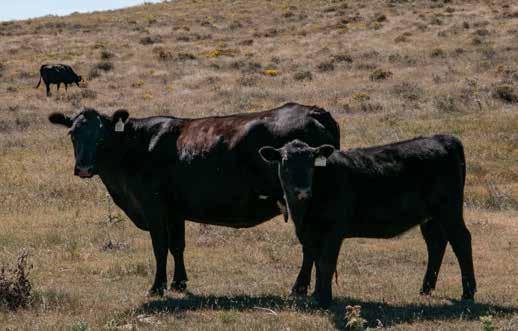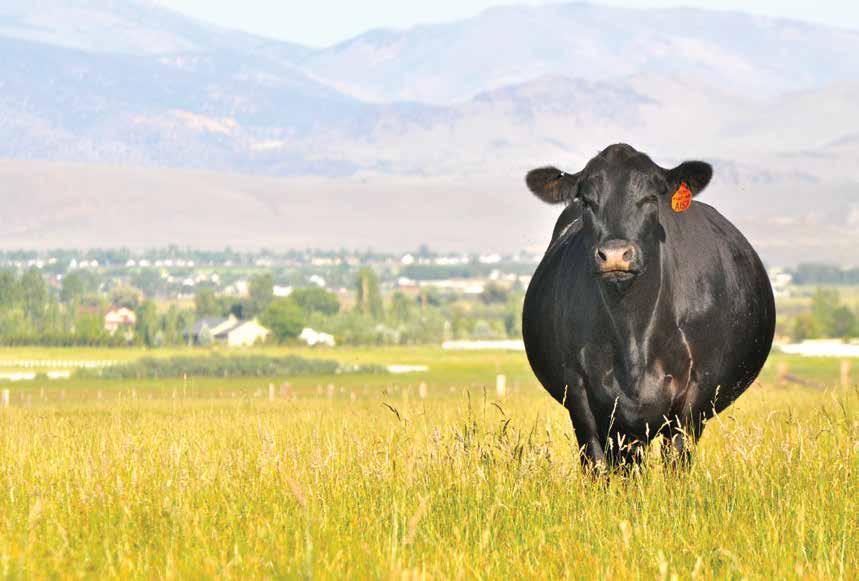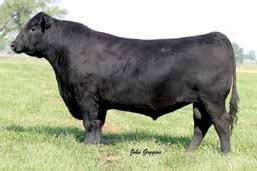
7 minute read
Weighing your weaning options
Weighing Your Options Evaluating variables and options for spring weaning health
by Bruce Derksen for the California Cattleman
Weaning time for fall calving operations is around the corner and the list of health and management decisions seems to grow each year. Selections need to be made on vaccine types and details to manage repetitive health concerns require finalization.
Should implants be a component of the plan? Does castration and dehorning still need to be accomplished? What about parasite controls or defenses against more unusual disorders?
Before the answers to these concerns can be put into action, the weaning process itself brings its own questions says Gabriele Maier, Extension Specialist for Beef Cattle Herd Health and Production at the University of California, Davis, (UC Davis).
Timing and manner both play a large role in how well the transition is made from mother’s care to the next stage in a calf’s life. While no one knows how much precipitation the current winter will bring, if conditions are dry and resources scarce, early weaning should be considered. It can reduce nutritional demand on cows helping them regain condition before the next breeding season.
“For the calves, immediately post weaning, it’s important to observe them for signs of sickness. Check their manure. If it’s too dry, they are not eating and drinking well enough. Too runny or with blood could be a sign of coccidia. Are they interested in their surroundings? If not, it could be a hint of sickness.”
Vaccination Choices
Maier says vaccinations should be a part of the conversation and urges producers to administer them two to three weeks before. “It’s a very stressful day in the life of the calf. Especially if that is the only vaccine a calf gets, if it’s on the same day as weaning, you really have to ask, how effective is it going to be?”
Choosing the type of vaccine, modified live or killed is also important.
“The advantage of the modified live is you’re giving an antigen for a bigger response to a virus. It’s the real thing.”
If respiratory diseases have been a significant issue in the past, she believes it makes sense to stay with the modified live.
“The main factor for every vaccine is to look at the benefits and the circumstances.” But she cautions producers to never say, ‘I don’t have any disease, so I’m going to quit.’ “That would be risky, because it’s not a problem until it is. Then it might be a train wreck.”
Maier notes it’s essential to keep gram negative vaccines in mind when planning inoculations. Veterinarians will provide guidance, but essentially certain vaccines given in too close a time period or handled improperly sometime
...CONTINUED ON PAGE 42
work together to overwhelm calves and cause them to go off feed.
“Adverse effects for gram negative bacteria are due to endotoxins in the vaccines that are cell components of the bacteria they contain. This can become a problem especially if they aren’t handled or stored correctly or shaken too rigorously. If producers have seen calves get pretty dumpy after vaccinations, they should either space the timing of gram-negative vaccines and/or evaluate their handling.”
Parasite Controls and Mineral Supplementation
When vaccinations are administered, it’s also a good time to use parasite controls and dewormer as newly weaned calves are a susceptible group says Juliana Ranches, Assistant Professor and Beef Cattle Specialist at Oregon State University.
“Every situation is different, plus now there are so many options. The most critical thing is to know what you have in your herd to avoid resistance to the various drugs. Some operations deworm without really knowing this information. I like to recommend doing fecal egg counts and sometimes evaluating the worm population present in the herd, so you can better allocate your resources.”
She also encourages producers to watch for mineral deficiencies. In Oregon, a selenium injection at birth is recommended as there has historically been a shortage of the mineral in pastures and forages.
“I think this is a reality in California as well,” she said. “There also seems to be a deficiency with copper. I like to use the injectable Multimin, which has a combination of selenium, copper, zinc and manganese. Applications can be done at birth, turnout and weaning to help cover other minerals lacking in forage.”
Pinkeye and Coccidiosis
Maier adds other health concerns to be wary of include pinkeye and coccidiosis.
For spring weaning, using a pinkeye treatment should be a consideration especially if it’s been an issue in the past and the vaccine has worked. “The problem is they need to be given at the right time. The booster should be delivered before fly season becomes a problem. If the strain circulating in the herd matches one in the vaccine, there’s a better chance of it working well.”
Maier also urges producers to think about coccidiosis in their calves. With this internal parasite, treatments differ from regular dewormer. Stress can trigger the condition portrayed as bloody diarrhea. Often, coccidiosis is a reoccurring problem and those experiencing it in the past and planning to keep their calves through a preconditioning period should use a group metaphylaxis treatment to avoid costly issues.
“Treating individuals with the diarrhea isn’t very efficient or effective. When you see the clinical signs, it’s kind of too late. Then you know it’s going to circulate in the group, and it will be kind of like playing ‘whack a mole’,” Maier said.
Treatments include easy to use products added to water or ionophores mixed in dry feeds or mineral mixes.
Castration, Dehorning and Branding
Spring weaning is also a time to clean up any castration, dehorning or branding tasks although Ranches always prefers the completion of these procedures as soon after birth as possible.
“The longer you wait, the more painful for the animal. If you can castrate at birth, it’s the best time to do it.”
While dehorning at birth may not be feasible as calves don’t always have horn buds, Ranches says the earlier the better for this task as well.
“Not because they are less susceptible to pain at that age, but they tend to recover better just because they don’t have to forage or walk for feed. They can dedicate their energy to recovery.”
Should Implants and Preconditioning be Part of the Plan?
Implanting should also be considered. Ranches says they are a beneficial technology for fall calving operations but often they’re not used.
“For fall calving, it’s a very profitable technology. An implant costs less than 2 dollars and can return 10 to 30 pounds at weaning, so looking at the investment ratio, it’s one of the best technologies out there.”
Ranches also believes the variations of preconditioning programs are alternatives if calves are destined for feedlots, both from a health perspective but also on the management side.
Her preconditioning definition focuses on supplementation prior to and after weaning, along with the more typical vaccination protocols. “Supplementation prior to weaning helps calves get used to human intervention and to a higher energy diet closer to what they’ll receive in the feedlot. This helps them transition better.”
Maier agrees and adds many of the organized programs with vaccination protocols regularly produce calves selling at higher premiums. She encourages producers to investigate these differences for a monetary advantage but also because health wise, it’s the right thing to do as these cattle move through the production chain.
For all the possibilities and decisions required during the spring weaning season, Maier notes most are heavily dependent on marketing options and health problems occurring in the past.
“How can these issues be avoided? And how can preventative medicine programs be tailored to address them?”
Whether calves are sold at weaning, or kept through a preconditioning period, their eventual location, fate and challenges are often unknown. Responsible animal welfare practices during the initial portion of life will stabilize their health and provide a production benefit down the road.
WARD RANCHES

15th Annual Bull Sale Saturday, March 20, 2021 1 p.m. at the ranch near Gardnerville, Nevada 1155 Foothill Road Gardnerville Nevada Selling 80 registered Angus bulls
40 18-month bulls • 40 yearlings All bulls DNA tested!

Guest Consignors:

Selling Early Fall 2019 - Early Spring 2020 Ranch Ready Bulls! By Industry-leading sires...



LD Capitalist 316 Casino Bomber WAR Broken Bow B344 T219 Plus sons of: PAHR Yeti, Black Granite and LD Capitalists 316, Connealy Rock 277P Sitz Powerball 696C and Connealy Emerald. Clean up bulls DPL All In S74 and DPL Function U34.

PERFORMANCE DATA SCROTAL MEASUREMENTS SEMEN TESTED ULTRASOUND MEASUREMENTS VOLUME DISCOUNT ON 5 OR MORE BULLS!

Gary Ward & Family (775)790-6148 David Medeiros (209) 765-0508 David Dal Porto (925) 250-5304 P.O. Box 1404, Gardnerville, NV 89410 wardranches24@gmail.com

PRODUCING BULLS THAT MEET THE DEMANDS OF THE INDUSTRY











